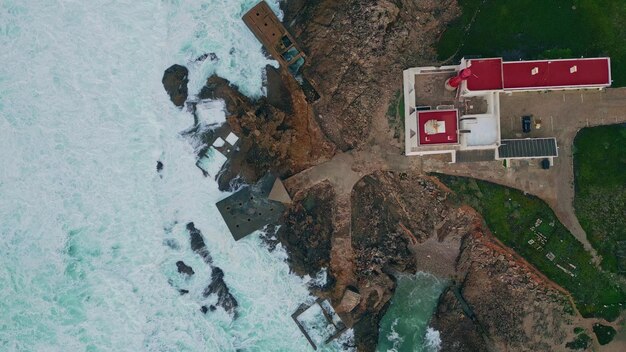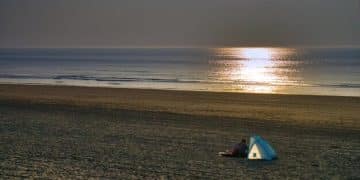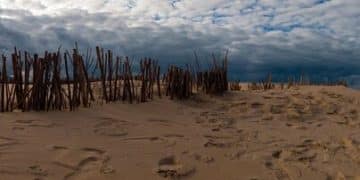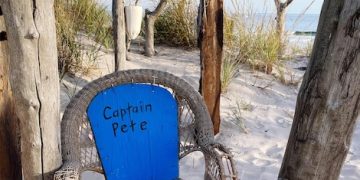Coastal Erosion Awareness: Impact on US Beaches & How to Help

Coastal erosion significantly reshapes US beaches, threatening ecosystems, infrastructure, and local economies, necessitating urgent awareness and proactive community engagement in protective and restorative measures to preserve these vital natural assets for future generations.
The beauty of US beaches is undeniable, attracting millions annually for leisure, industry, and natural wonder. Yet, beneath their seemingly timeless allure lies a dynamic threat: coastal erosion. This ongoing process, influenced by natural forces and human activities, is progressively reshaping our shorelines. Understanding the impact of erosion on these invaluable natural resources and learning Coastal Erosion Awareness: Understanding the Impact on US Beaches and How to Help is crucial for their preservation.
The Persistent Threat of Coastal Erosion on US Shores
Coastal erosion is a natural, dynamic process, but its acceleration due to climate change and human activities poses an escalating threat to US beaches. This section explores the fundamental mechanisms driving erosion and highlights why its impact is becoming increasingly pronounced across the nation’s diverse coastlines.
The relentless push and pull of ocean currents, waves, and tides are primary natural forces at play. Over centuries, these forces have sculpted our coastlines, creating the varied and vibrant beaches we cherish today. However, human interventions, such as the construction of dams that reduce sediment supply to beaches, or the hardening of shorelines with seawalls, can disrupt this natural balance, often exacerbating erosion in adjacent areas.
Natural Drivers of Coastal Erosion
Several natural phenomena contribute significantly to coastal erosion. Understanding these drivers is the first step toward effective mitigation and adaptation strategies.
- Wave Action: Dominant force, especially during storms, directly impacts shorelines by removing sediment.
- Tides and Currents: Longshore currents transport sand along the coast, and extreme tides can reach higher elevations, eroding dunes and bluffs.
- Sea Level Rise: As global temperatures increase, expanding oceans and melting glaciers lead to higher sea levels, allowing waves to reach further inland and causing permanent inundation of low-lying beaches.
- Storm Surges: Extreme weather events, such as hurricanes and nor’easters, generate powerful storm surges that cause rapid and extensive erosion, often reshaping coastlines in a single event.
The interplay of these natural factors determines the rate and severity of erosion in any given location. For instance, a gently sloping beach might be more susceptible to erosion from rising sea levels, while a steep bluff might suffer more from intense storm-driven wave action.
Human Activities Accelerating Erosion
While natural forces are inherent, human activities often amplify the problem. Developing coastal areas, extracting sand, and altering natural sediment flows contribute to the vulnerability of our beaches.
- Coastal Development: Building close to the shoreline often leads to the construction of protective structures (seawalls, jetties) that can starve downdrift beaches of sand.
- Dredging and Sand Mining: Removing sand from coastal systems, whether for navigation or construction, can deplete natural sediment supplies necessary for beach replenishment.
- Dam Construction: Dams on rivers reduce the amount of sediment flowing downstream to coastal areas, thereby diminishing the natural replenishment of beaches.
These human influences can create a complex web of unintended consequences, where actions taken in one area lead to detrimental effects in another. For example, a jetty built to protect a harbor entrance might inadvertently cause severe erosion on a beach just a few miles down the coast by interrupting the natural flow of sand.
In conclusion, coastal erosion is a formidable challenge for US beaches, driven by a combination of powerful natural forces and a history of human activities that have often disrupted delicate coastal ecosystems. Recognizing these drivers is essential for developing informed and sustainable strategies for the future of our valuable shorelines.

Ecological and Economical Repercussions of Eroding US Coastlines
The impact of coastal erosion extends far beyond the mere “loss of sand.” It poses a significant threat to the environmental integrity of delicate ecosystems and inflicts substantial economic damage on coastal communities, underscoring the urgency of awareness and action.
Erosion directly affects a multitude of species and their habitats, many of which are vital for maintaining the health of coastal environments. From nesting sea turtles to essential marsh grasses, the displacement or destruction of these habitats can trigger cascading ecological failures. Furthermore, the economic toll is immense, impacting tourism, fishing industries, and property values, crippling the very fabric of coastal life.
Threats to Biodiversity and Habitats
Coastal ecosystems are some of the most productive and biodiverse areas on Earth. Erosion directly undermines these critical habitats, leading to a decline in species and ecosystem services.
- Loss of Nesting Grounds: Beaches are crucial nesting sites for endangered sea turtles and various bird species. Erosion directly reduces the available suitable habitat, jeopardizing their reproductive success.
- Destruction of Dune Systems: Coastal dunes act as natural barriers and provide unique habitats for specialized flora and fauna. Erosion removes these dunes, exposing inland areas to greater storm impacts and eliminating critical ecological niches.
- Degradation of Wetlands: Salt marshes and mangroves are vital for filtering water, protecting shorelines, and serving as nurseries for marine life. Erosion and saltwater intrusion, exacerbated by sea level rise, transform or destroy these wetlands.
The intricate balance of these ecosystems means that the loss of one component can have far-reaching effects. For instance, the destruction of oyster reefs due to erosion not only impacts the oyster population but also reduces natural water filtration and habitat for numerous other marine organisms, diminishing the overall health of the estuary.
Economic Fallout for Coastal Communities
Coastal areas are often economic powerhouses, relying on tourism, commercial fishing, and real estate. Erosion directly undermines these pillars, leading to significant financial losses and long-term economic instability.
- Damage to Infrastructure: Roads, buildings, utilities, and other critical infrastructure located near the coast are vulnerable to erosion, requiring expensive repairs, relocation, or abandonment.
- Decline in Tourism and Recreation: Eroded beaches are less attractive to tourists and recreational users, resulting in reduced visitor numbers, loss of tourism revenue, and job losses in related industries.
- Impact on Fisheries: The degradation of coastal habitats, such as estuaries and wetlands, disrupts the life cycles of many fish and shellfish, affecting commercial and recreational fishing industries.
- Property Value Depreciation: Homes and businesses in eroding coastal zones can experience significant decreases in property value, leading to financial hardship for property owners and reduced tax revenues for local governments.
The economic impact of erosion is not limited to immediate damage from storms. The continuous, slow loss of land and infrastructure demands constant investment in protection or relocation, often placing a heavy burden on local and state budgets. Furthermore, the erosion of cultural sites and historical landmarks represents an irreplaceable loss of heritage, adding another dimension to the comprehensive damage.
In essence, coastal erosion on US shores represents a multifaceted crisis, simultaneously threatening the delicate balance of natural ecosystems and the robust economic foundations of countless communities. Addressing this issue requires a comprehensive strategy that acknowledges both the environmental and financial ramifications.
Innovative Engineering Approaches to Combat Coastal Erosion
The escalating challenge of coastal erosion has spurred the development of various engineering solutions, ranging from traditional hardened structures to more nature-based approaches. Each method comes with its own set of benefits, limitations, and ecological considerations, making careful planning paramount.
Engineers and coastal managers are continuously seeking innovative ways to protect shorelines while minimizing environmental impact. The choice of a particular strategy often depends on site-specific conditions, the severity of erosion, available resources, and long-term sustainability goals. Understanding these diverse approaches is crucial for effective coastal management.
Hardened Structures: A Traditional but Debated Approach
Historically, coastal protection has often relied on “hard” engineering solutions designed to physically block or redirect wave energy. While effective in specific contexts, these structures frequently come with environmental trade-offs.
- Seawalls and Revetments: These formidable barriers are built parallel to the shoreline to protect structures from wave action. While they offer robust protection to the land directly behind them, they can lead to increased erosion on adjacent beaches by reflecting wave energy offshore or preventing natural dune formation.
- Groins and Jetties: Structures built perpendicular to the shoreline, groins aim to trap sand moving along the coast, while jetties stabilize navigation channels. Although they accumulate sand on their updrift side, they often cause significant erosion on the downdrift side, disrupting the natural sediment transport system.
- Breakwaters: Built offshore, parallel to the coast, breakwaters reduce wave energy reaching the shore, thereby promoting sediment deposition behind them. They can create sheltered areas for recreation but may also alter natural current patterns and marine habitats.
The long-term efficacy and environmental consequences of hardened structures are subjects of ongoing debate. While they may provide immediate protection, their tendency to alter natural coastal processes can in turn exacerbate erosion elsewhere, leading to a costly cycle of intervention.
Soft Solutions and Nature-Based Engineering
Recognizing the limitations of hard structures, there’s a growing emphasis on “soft” engineering and nature-based solutions that work with natural processes rather than against them. These approaches often provide broader ecological benefits.
- Beach Nourishment: This involves dredging sand from offshore sources or land-based quarries and pumping it onto eroded beaches to widen and raise the shoreline. It’s a temporary solution requiring periodic re-nourishment, but it restores recreational areas and provides storm protection.
- Dune Restoration and Vegetation: Rebuilding or enhancing natural dune systems and planting native vegetation (like dune grasses) helps stabilize sand, provides natural storm protection, and creates essential wildlife habitat.
- Living Shorelines: This approach uses natural elements, such as oyster reefs, salt marshes, or submerged aquatic vegetation, to protect shorelines from erosion, filter water, and provide habitat. They are a flexible and ecologically beneficial alternative to seawalls.
- Sediment Management: Comprehensive strategies that aim to maintain the natural flow of sand within coastal systems, potentially involving bypassing sand around inlets or restoring natural river sediment supply.
These nature-based solutions often integrate ecological restoration with coastal protection, offering a more sustainable and resilient approach. They are generally more adaptable to future conditions, such as sea level rise, and provide multiple co-benefits, including improved water quality and enhanced biodiversity.
The challenge lies in selecting the most appropriate and sustainable engineering solution for each unique location, often combining elements of both hard and soft approaches in integrated coastal management plans. This demands a thorough understanding of coastal dynamics, ecological impacts, and community needs, emphasizing a collaborative and adaptive planning process.
Policy Frameworks and Government Initiatives for Coastal Protection
Addressing coastal erosion at a national scale requires robust policy frameworks and coordinated government initiatives. In the US, a complex web of federal, state, and local regulations and programs aims to manage coastal development, fund protective measures, and promote sustainable practices.
These policies often balance competing interests, such as economic development, environmental protection, and public safety. A deeper understanding of these frameworks is essential for communities and individuals seeking to engage with or benefit from coastal protection efforts.
Federal Policies and Funding Mechanisms
At the federal level, various agencies and legislative acts play a crucial role in shaping coastal management and funding erosion control projects. These initiatives often provide the backbone for large-scale interventions.
- Coastal Zone Management Act (CZMA): Enacted in 1972, this act encourages states to develop and implement comprehensive coastal management programs. It provides federal funding and technical assistance to states for land and water use planning in coastal zones, including erosion management.
- National Flood Insurance Program (NFIP): Administered by FEMA, NFIP offers flood insurance to communities that adopt and enforce floodplain management ordinances. While not directly an erosion control policy, its floodplain mapping and building standards influence development in erosion-prone areas. Its reform continuously seeks to address repetitive losses in high-risk areas.
- Army Corps of Engineers (USACE): USACE is involved in numerous civil works projects, including maintaining navigation channels and undertaking beach nourishment projects for shore protection. They conduct studies, design, and construct projects that often directly impact coastal erosion.
- National Oceanic and Atmospheric Administration (NOAA): NOAA conducts extensive research on coastal processes, climate change, and sea level rise. It provides data, tools, and technical assistance to state and local governments for coastal planning and resilience building.
Federal funding, often through grants and cooperative agreements, is critical for supporting state and local coastal management efforts, especially for large-scale projects like major beach nourishment operations that involve significant financial and logistical challenges.
State and Local Responses and Challenges
While federal policies provide a broad framework, the implementation and specific strategies for coastal erosion management largely fall to state and local governments. These entities often face unique challenges tailored to their specific geographies and socio-economic conditions.
- Building Codes and Setbacks: Many coastal states and municipalities have regulations that dictate how close structures can be built to the shoreline (setbacks) and mandate specific building standards to withstand coastal hazards.
- Coastal Commissions and Boards: State-level coastal zone management programs are often overseen by commissions or boards responsible for issuing permits for coastal development, regulating activities that impact erosion, and developing regional coastal plans.
- Erosion Control Districts: Some communities have established special districts with the authority to levy taxes or fees to fund local erosion control projects, such as beach nourishment or dune restoration.
Local communities face the difficult task of balancing the desires of property owners, the needs of the tourism industry, and the long-term environmental sustainability of their coastlines. Funding remains a persistent challenge, particularly for smaller communities with limited tax bases. Additionally, the dynamic nature of coastal erosion means that management plans must be flexible and adaptive, requiring ongoing monitoring and adjustments to policies and protective measures.
Effective coastal erosion management in the US thus relies on a multi-tiered approach, combining top-down federal guidance and funding with localized decision-making and implementation. The ongoing challenge is to foster greater integration and coordination across these levels of governance to ensure a resilient future for US beaches.
The Critical Role of Community Engagement and Education
While engineering solutions and government policies are vital in combating coastal erosion, the sustained success of these efforts hinges significantly on community engagement and public education. Informed and active citizens can serve as powerful advocates and partners in protecting their local beaches.
Raising awareness about the causes and consequences of coastal erosion empowers individuals to make more responsible choices, support effective policies, and participate directly in conservation efforts. This section delves into how communities can mobilize and educate their members to foster a culture of coastal stewardship.
Fostering Awareness Through Education Programs
Education is a cornerstone of effective coastal management. Programs designed to inform the public about coastal processes, the impacts of erosion, and sustainable practices can significantly shift perceptions and behaviors.
- School Curricula: Integrating coastal ecology, climate change impacts, and erosion awareness into K-12 education can foster a lifelong appreciation and understanding of coastal environments among younger generations.
- Public Workshops and Seminars: Organizing accessible workshops for residents, property owners, and businesses provides critical information about local erosion issues, potential solutions, and individual roles in mitigation. These platforms can also facilitate discussions and address community-specific concerns.
- Citizen Science Initiatives: Engaging volunteers in monitoring beach changes, collecting data on erosion rates, or tracking coastal wildlife provides valuable scientific data while fostering a deeper connection and understanding among participants. Many organizations offer opportunities for citizens to contribute to real-world research.
- Informational Campaigns: Utilizing various media channels—local news, social media, public service announcements, and interpretive signs at beaches—to disseminate clear and concise messages about coastal erosion and practical ways to help.
Effective education moves beyond simply presenting facts; it inspires a sense of ownership and responsibility. When people understand the direct link between their actions and the health of their beaches, they are more likely to support and participate in conservation efforts.
Mobilizing for Action: Volunteerism and Advocacy
Beyond education, active participation by community members and local organizations is indispensable. Grassroots efforts can drive policy change, execute conservation projects, and sustain long-term stewardship.
- Beach Cleanups: While not directly addressing erosion, regular beach cleanups raise awareness about overall coastal health, draw attention to the fragility of these environments, and keep shorelines pristine for recovery efforts.
- Dune Planting Campaigns: Volunteer-led initiatives to plant native vegetation on dunes are highly effective in stabilizing sand, rebuilding natural barriers, and fostering community camaraderie around conservation.
- Advocacy for Sustainable Policies: Community groups can lobby local and state governments for stronger coastal setback regulations, increased funding for nature-based solutions, or the protection of critical coastal habitats. Their collective voice can significantly influence decision-makers.
- Supporting Local Conservation Organizations: Donating time, money, or expertise to local non-profits focused on coastal conservation provides crucial resources for their ongoing work, from habitat restoration to policy advocacy.
- Adopting Green Infrastructure: Encouraging property owners to adopt practices like permeable paving, rainwater harvesting, and native landscaping can reduce stormwater runoff, which contributes to erosion, particularly in urban coastal settings.
Community engagement transforms passive awareness into active stewardship. By participating in these efforts, individuals become direct stakeholders in the health of their beaches, fostering a sense of collective responsibility that is essential for long-term resilience against coastal erosion.
Ultimately, a holistic approach to coastal erosion management must integrate scientific understanding, robust policies, and, perhaps most importantly, an empowered and engaged citizenry dedicated to preserving the invaluable US beaches for future generations.
Future Projections and Adaptation Strategies for US Beaches
As climate change accelerates, future projections for US beaches indicate that coastal erosion will intensify, making adaptive strategies more critical than ever. The focus is shifting from merely reacting to erosion to proactively building resilience against future impacts.
Understanding these projections and implementing forward-looking adaptation strategies are essential for safeguarding coastal communities and ecosystems. This final section explores the anticipated challenges and the innovative approaches being developed to ensure the long-term viability of our invaluable shorelines.
Anticipated Challenges from Climate Change
The nexus of climate change and coastal erosion is projected to worsen existing problems and introduce new complexities, demanding comprehensive and flexible responses.
- Accelerated Sea Level Rise: Projections indicate a significant increase in the rate of sea level rise, leading to more frequent inundation, permanent loss of low-lying beaches, and increased erosion of bluffs and dunes.
- Increased Storm Intensity: While the frequency of tropical storms may vary, scientific consensus suggests that major storms (hurricanes, nor’easters) are likely to become more intense, bringing higher storm surges, stronger winds, and heavier rainfall, leading to more dramatic and rapid erosion events.
- Ocean Acidification and Warming: These related issues can indirectly impact coastal resilience by stressing fragile ecosystems like coral reefs and oyster beds that naturally protect shorelines from wave energy.
- Ecosystem Migration Challenges: As sea levels rise, habitats like salt marshes try to migrate inland, but are often blocked by coastal development, leading to “coastal squeeze” and further ecosystem loss.
These interconnected challenges paint a stark picture for the future of US beaches, emphasizing the need for robust planning that considers dynamic coastal processes rather than static boundaries.
Innovative Adaptation Strategies
To meet these future challenges, a range of adaptation strategies are being developed and implemented, moving beyond traditional erosion control to embrace broader concepts of resilience and managed retreat.
- Managed Retreat/Relocation: In some highly vulnerable areas, the most sustainable long-term solution may be to strategically relocate infrastructure and communities away from the eroding shoreline, allowing natural coastal processes to continue. This is often a controversial but increasingly necessary discussion.
- Regional Sediment Management: Moving beyond localized projects, this approach considers the entire coastal sediment system, aiming to optimize the movement and placement of sand to benefit multiple beaches and habitats across a broader region.
- Ecological Restoration at Scale: Large-scale projects focused on restoring entire coastal ecosystems—such as restoring barrier islands, extensive oyster reefs, or vast tracts of salt marsh—provide significant natural protection and enhance biodiversity.
- Advanced Mapping and Monitoring: Utilizing cutting-edge technologies like LIDAR and satellite imagery to precisely map coastal changes and predict future erosion patterns, allowing for more informed and proactive planning.
- Building Code Updates for Resilience: Revising building codes to require structures in coastal hazard zones to be built higher, stronger, or with more flood-resistant materials, making them more resilient to extreme weather and rising seas.
These adaptation strategies represent a paradigm shift in coastal management, moving from a reactive “hold the line” approach to one that emphasizes flexibility, ecosystem services, and long-term sustainability. The challenge lies in securing political will, financial resources, and widespread community acceptance for these often complex and sometimes controversial solutions.
The future of US beaches depends on our ability to anticipate, adapt, and innovate. By embracing a combination of engineering, policy, and community-led initiatives, coupled with a deep understanding of future climate impacts, we can strive to preserve these vital natural and economic assets for generations to come.
| Key Point | Brief Description |
|---|---|
| 🌊 Erosion Drivers | Natural forces (waves, tides, sea-level rise) and human activities (development, dams) accelerate coastal wear. |
| 💸 Impact | Threatens ecosystems, biodiversity, infrastructure, tourism, and real estate values. |
| 🛠️ Solutions | Includes hard structures (seawalls) and soft solutions (beach nourishment, living shorelines). |
| 🤝 Community Action | Education, volunteerism, and advocacy are key for sustainable coastal protection. |
Frequently Asked Questions About Coastal Erosion
▼
Coastal erosion is the natural process where land along the coast is worn away by waves, tides, and currents. It’s exacerbated by natural factors like sea level rise and storm surges, as well as human activities such as coastal development, dam construction, and sand mining that disrupt natural sediment flow.
▼
Erosion leads to loss of beach area, threatening critical wildlife habitats like sea turtle nesting sites. Economically, it causes damage to infrastructure, decreases property values, and negatively impacts tourism and fishing industries vital to coastal communities. Its effects are far-reaching and deeply felt locally.
▼
Common solutions include “hard” structures like seawalls, groins, and breakwaters, which aim to block or redirect wave energy. “Soft” solutions, preferred for their ecological benefits, include beach nourishment, dune restoration, and building “living shorelines” using natural elements like oyster reefs and marsh grasses.
▼
Individuals can participate in beach cleanups, volunteer for dune planting, support conservation organizations, and advocate for sustainable coastal policies. Communities can organize educational workshops, launch citizen science initiatives, and encourage green infrastructure development to foster a culture of stewardship.
▼
The outlook suggests intensified erosion due to accelerated sea level rise and increased storm intensity. Long-term strategies focus on building resilience through regional sediment management, large-scale ecosystem restoration, managed retreat where necessary, and adapting building codes to future climate impacts, ensuring the longevity of coastal resources.
A Collective Responsibility for Coastal Resilience
The escalating challenge of coastal erosion on US beaches demands an integrated and proactive response that transcends traditional boundaries. From understanding the complex interplay of natural forces and human activities to implementing innovative engineering solutions, policy frameworks, and fostering robust community engagement, every facet plays a vital role. The future vitality of these invaluable natural assets—their ecosystems, economies, and intrinsic beauty—hinges on our collective ability to adapt, mitigate, and inspire a deeper appreciation for their vulnerability. By fostering Coastal Erosion Awareness: Understanding the Impact on US Beaches and How to Help, we strengthen the collective resolve to protect our shorelines for future generations, ensuring their resilience against the persistent forces of change.





